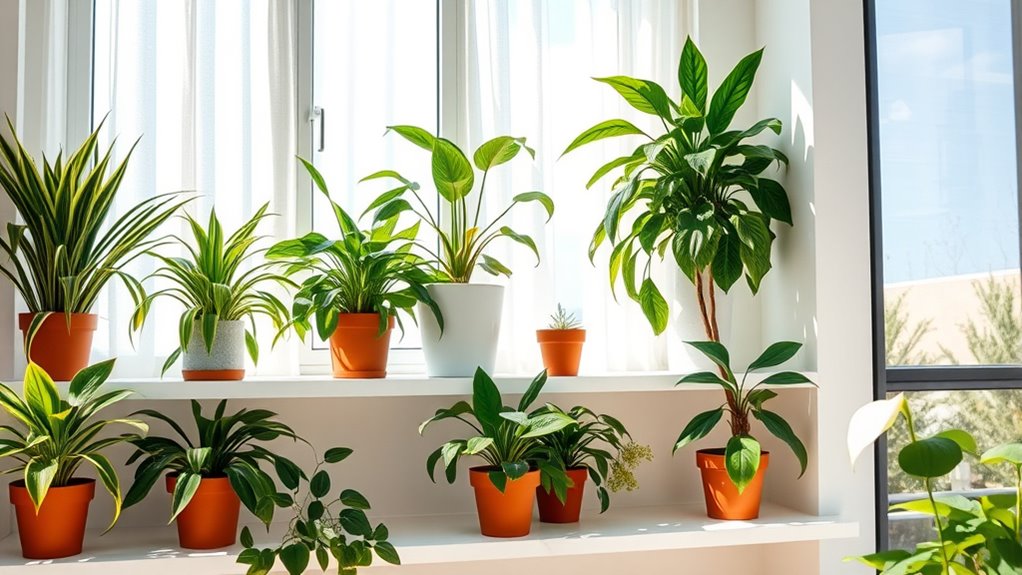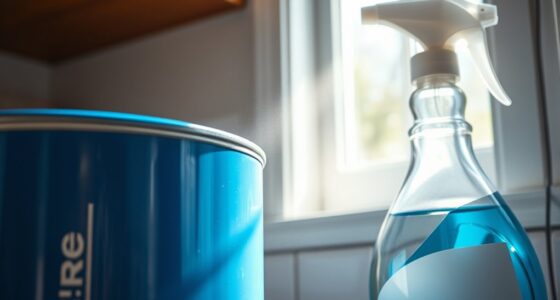Plants improve indoor air by absorbing harmful pollutants like formaldehyde, benzene, and dust through their leaves and roots. They release oxygen and regulate humidity, making the air fresher and easier to breathe. Their natural filtration process breaks down toxins, reducing indoor pollution from household products and paints. Proper placement and care maximize their purifying ability. If you’d like to discover which plants work best and how to care for them, keep exploring this topic.
Key Takeaways
- Plants absorb airborne pollutants like formaldehyde and benzene through leaves and roots, trapping toxins indoors.
- Photosynthesis in plants releases oxygen and regulates humidity, improving overall indoor air quality.
- Microscopic pores called stomata facilitate gas exchange, helping filter and degrade harmful airborne chemicals.
- Plants trap dust, mold spores, and pet dander on their surfaces, reducing indoor allergens.
- Proper care and placement enhance plants’ ability to effectively purify indoor air over time.
The Science Behind Plants and Air Quality
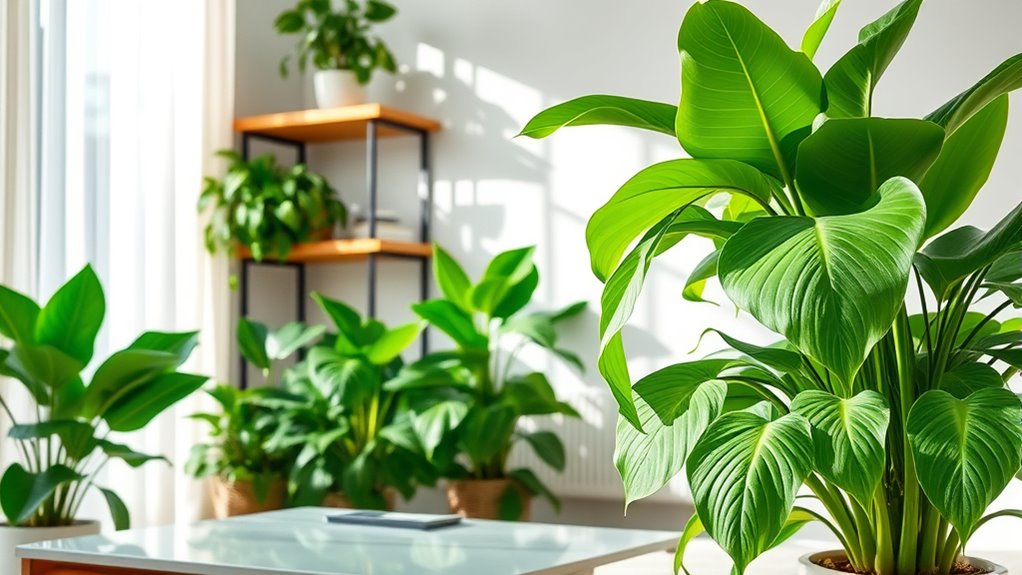
Plants improve indoor air quality because they naturally absorb carbon dioxide and release oxygen through photosynthesis. When sunlight hits their leaves, plants convert CO₂ and water into glucose and oxygen. This process not only supplies fresh oxygen but also helps regulate humidity levels. Additionally, plants take in airborne pollutants like formaldehyde and benzene through their leaves and roots, trapping these toxins inside. This natural filtering process reduces the concentration of harmful chemicals in your indoor environment. The microscopic pores on leaves, called stomata, facilitate gas exchange, making plants efficient natural air purifiers. By continuously engaging in photosynthesis, plants actively work to improve the air you breathe, creating a healthier, more balanced indoor atmosphere. Moreover, selecting appropriate plant species can maximize air purification benefits and enhance your indoor air quality further.
Common Indoor Plants That Purify Air
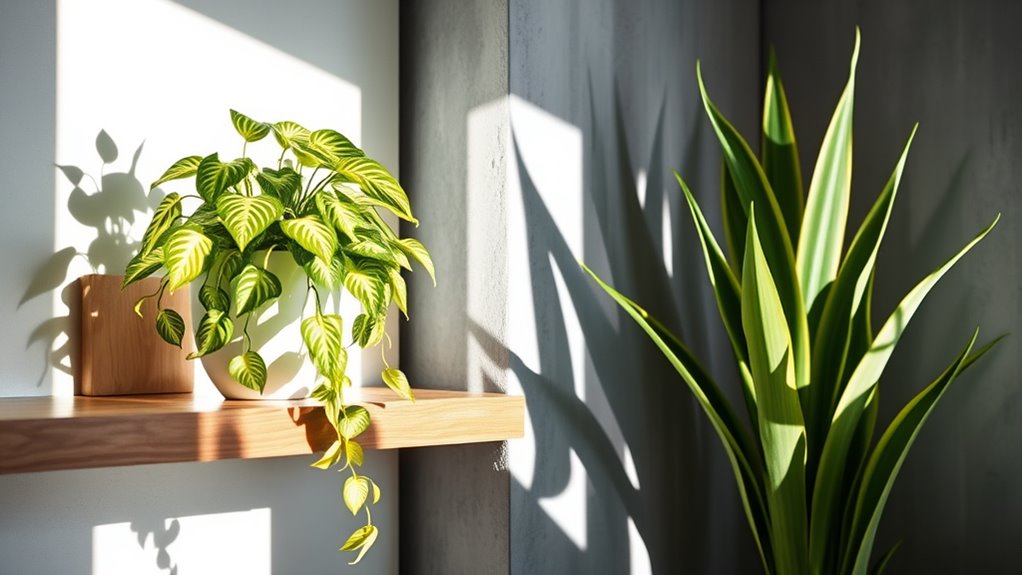
If you’re looking to improve your indoor air quality, several popular plants can help. These low-maintenance options work well in small spaces and don’t require much effort to keep healthy. Consider adding these plants to your home for cleaner, fresher air.
Popular Air-Purifying Options
Many popular indoor plants are effective at filtering toxins from the air, making them a great addition to your home or office. The Snake Plant is known for its ability to remove formaldehyde, xylene, and toluene, and it thrives on minimal care. Spider Plants are easy to grow and excel at eliminating carbon monoxide and formaldehyde. Peace Lilies not only improve air quality but also add a touch of elegance; they target ammonia, benzene, and formaldehyde. Boston Ferns are great for humid environments and help filter airborne pollutants like formaldehyde. These plants combine beauty with air-purifying power, making them perfect choices for enhancing your indoor environment effortlessly. Adding these popular options can markedly improve your air quality while requiring minimal effort. Embracing the legacy of exploration can inspire us to discover new ways to care for and appreciate our indoor ecosystems.
Low-Maintenance Choices
For those seeking effective air purification without the hassle of high maintenance, several common indoor plants fit the bill perfectly. These plants require minimal watering, tolerating low light and infrequent care. They’re ideal if you want cleaner air without extra effort. Here’s a quick look at some popular options:
| Plant | Light Needs | Care Tips |
|---|---|---|
| Snake Plant | Low to bright indirect | Water once every 2-6 weeks |
| ZZ Plant | Low to bright indirect | Let soil dry between watering |
| Pothos | Low to bright indirect | Water when top inch dries |
These hardy plants keep your air clean with minimal fuss and are well-suited for remote work environments where maintaining a healthy space is essential.
Effective for Small Spaces
When space is limited, choosing the right indoor plants becomes essential for maintaining fresh air without cluttering your home. Luckily, many compact plants can purify the air while fitting into small areas. The snake plant is a top choice; it’s tall but narrow, and it requires minimal care. Pothos is another great option—its trailing vines can hang in small pots or shelves, adding greenery without taking up much room. ZZ plants are compact and resilient, perfect for tight corners. Spider plants are also ideal, as they grow vertically and produce air-purifying foliage. These plants not only improve your indoor air quality but also add a touch of nature to your cozy space. Incorporating color accuracy into your plant choices can enhance the visual appeal and overall atmosphere of your indoor environment. With these options, you can enjoy cleaner air without sacrificing precious square footage.
How Plants Remove Toxins From Indoor Environments
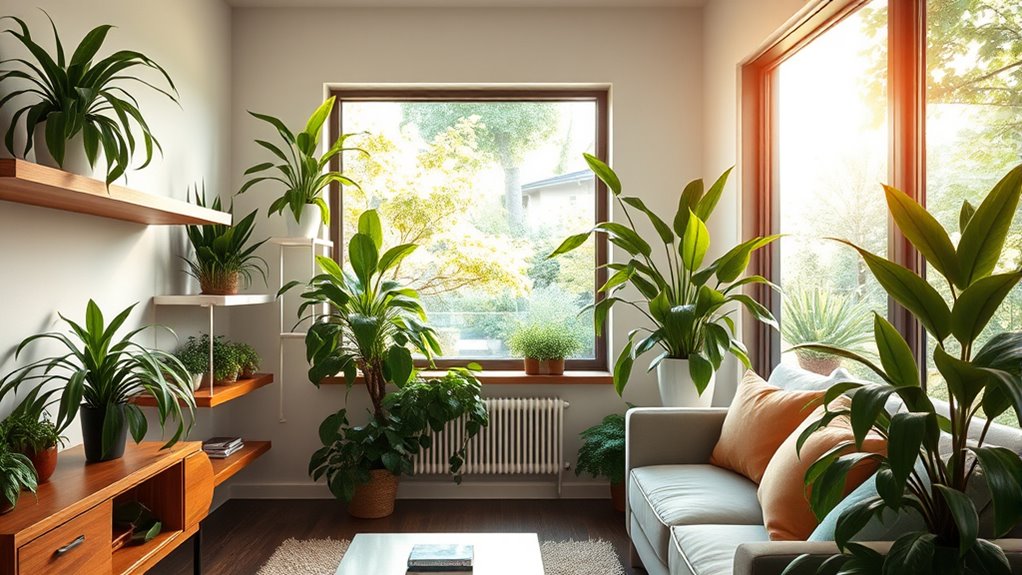
Plants naturally absorb toxins through their leaves and roots, helping to clean the air you breathe. They act as living filters, breaking down harmful chemicals into less toxic substances. This process substantially boosts indoor air quality and creates a healthier environment for you. Additionally, some plants can help remove specific indoor toxins, further enhancing the air purification process.
Natural Toxin Absorption
Indoor plants actively absorb toxins such as formaldehyde, benzene, and trichloroethylene through their leaves and roots, helping to clean the air you breathe. These toxins come from household products, furniture, and paints, posing health risks over time. Plants use their natural processes to filter these harmful chemicals, reducing indoor pollution. Mindfulness practices can further enhance your awareness of indoor air quality and promote a healthier environment.
Enhanced Air Purity
Because of their natural ability to absorb and break down airborne toxins, plants considerably enhance indoor air purity. They actively filter pollutants like formaldehyde, benzene, and trichloroethylene by trapping and degrading these harmful substances. As you bring plants into your space, you’re not just adding greenery; you’re creating a cleaner environment. Plants release oxygen and absorb carbon dioxide, further improving air quality. Their leaves and roots provide surface area where toxins can adhere and be processed. This ongoing natural filtration reduces airborne pollutants that can cause health issues like headaches, allergies, and respiratory problems. Additionally, vibrational energy emitted by plants can support a positive and harmonious indoor atmosphere. By incorporating plants into your home or office, you support a healthier indoor atmosphere, making it fresher, safer, and more comfortable to breathe.
Living Filter Mechanisms
Plants actively act as living filters by utilizing their roots, leaves, and microbial communities to remove toxins from the air. When you place a plant indoors, its leaves absorb pollutants like formaldehyde and benzene through tiny pores called stomata. These toxins are then broken down or transformed into harmless substances within the plant’s tissues. Meanwhile, the roots and surrounding soil host microbes that further degrade airborne chemicals, enhancing purification. This symbiotic relationship boosts the plant’s ability to clean the air continuously. Additionally, the integration of these natural processes demonstrates how AI in education can be applied to optimize and understand environmental health strategies. As a result, your indoor environment becomes healthier and fresher. By supporting natural filtration through these mechanisms, plants do more than add beauty—they actively improve your indoor air quality. Their living filter system works silently and efficiently, providing ongoing detoxification.
The Role of Plants in Increasing Oxygen Levels
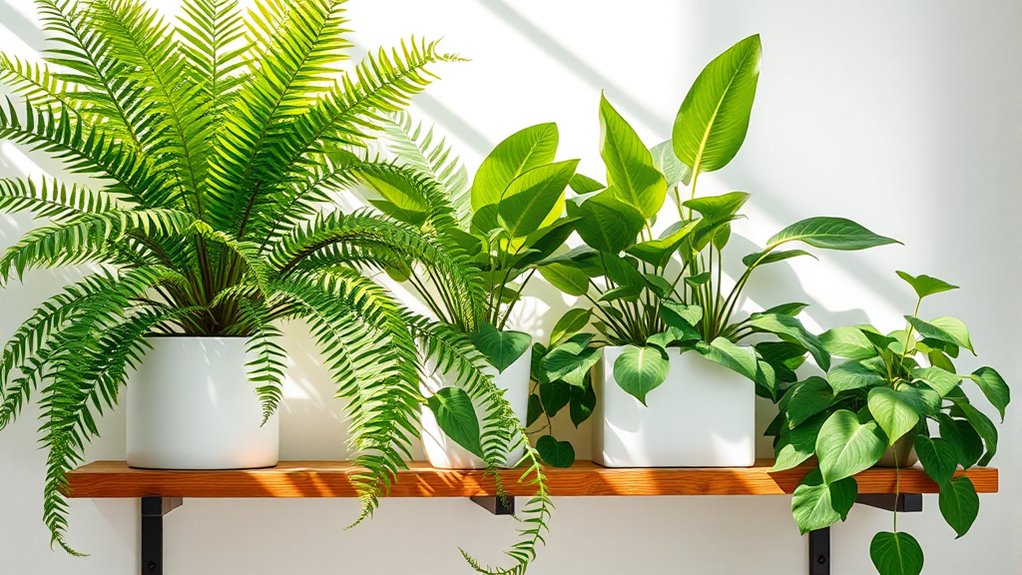
While many people focus on plants’ ability to filter pollutants, their role in boosting oxygen levels is equally important. During photosynthesis, plants absorb carbon dioxide and release oxygen, helping to improve indoor air quality. This process is essential, especially in enclosed spaces where fresh air may be limited. By increasing oxygen, plants enhance your overall well-being, alertness, and energy levels. They create a healthier environment for work and relaxation.
Plants boost indoor oxygen levels, improving air quality and supporting your well-being in enclosed spaces.
- Convert CO₂ into oxygen through photosynthesis
- Maintain a steady oxygen supply indoors
- Support respiratory health by increasing oxygen availability
- Complement ventilation systems naturally
Benefits of Plants for Reducing Indoor Pollutants
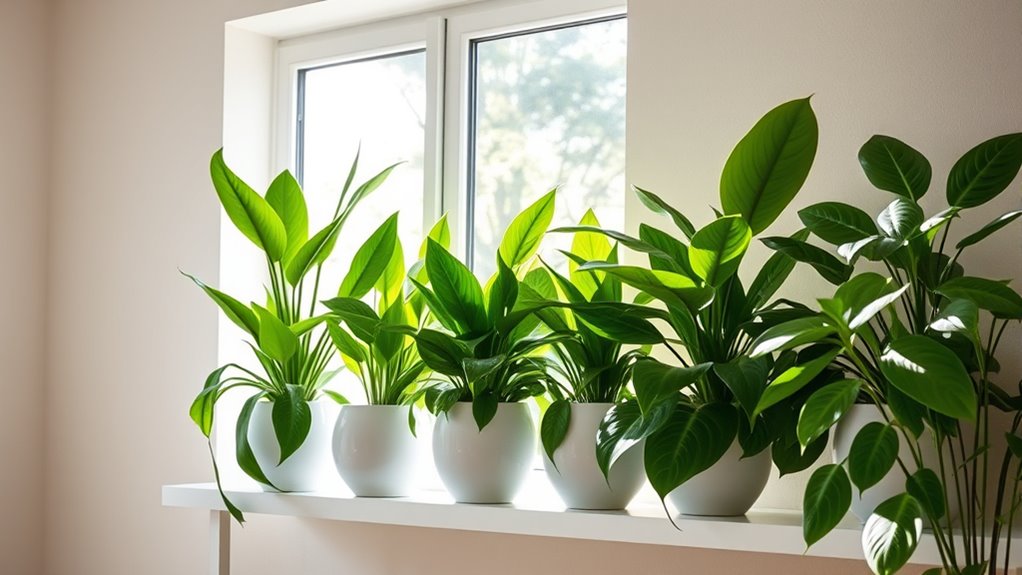
Have you ever wondered how indoor greenery can clean the air you breathe? Plants do more than add beauty; they actively reduce indoor pollutants. They absorb airborne toxins like formaldehyde, benzene, and trichloroethylene through their leaves and roots. As they take in these chemicals, they break them down into less harmful substances, improving air quality. Additionally, plants can trap dust, mold spores, and pet dander on their surfaces, preventing these particles from circulating in your home. This natural filtering process helps create a healthier environment, especially for allergy sufferers or those sensitive to indoor pollutants. By simply having the right plants indoors, you can reduce exposure to many common airborne toxins, making your indoor space safer and more breathable.
Techniques for Maximizing Air Purification With Plants

To maximize the air-cleaning benefits of your indoor greenery, it’s important to arrange and care for your plants thoughtfully. Place your plants where they’ll receive adequate light and avoid overcrowding, which can hinder airflow and reduce effectiveness. Regularly clean the leaves to remove dust that blocks absorption of toxins. Group plants with similar needs together to create a microenvironment that promotes healthy growth. Use pots with good drainage to prevent root rot, which can compromise the plant’s health and filtering ability. Additionally, rotate your plants periodically to ensure even exposure to light and air circulation, boosting their overall purification capacity. Incorporating proper plant care practices can further enhance their ability to improve indoor air quality.
Factors Affecting the Air-Filtering Efficiency of Indoor Plants

Several factors influence how effectively indoor plants can filter air, and understanding these can help you optimize their performance. First, the type of plant matters; some species are better at removing specific pollutants, like snake plants or pothos. The plant’s size and leaf surface area also play a role—you’ll see better filtration with larger, fuller plants. Additionally, the plant’s health impacts its ability to clean the air; healthy, well-maintained plants absorb and filter pollutants more efficiently. The placement of your plants influences airflow and exposure to indoor pollutants, so positioning them in areas with higher air circulation can boost their effectiveness. Finally, the number of plants and their proximity to sources of pollution, like smoking or cooking, directly affect how much air they can purify. Plant selection also matters, as choosing the right species can significantly enhance air quality.
Tips for Caring for Air-Purifying Houseplants

Caring for your air-purifying houseplants guarantees they stay healthy and effective at cleaning indoor air. To keep them thriving, ensure they receive appropriate light—bright but indirect sunlight works well for most varieties. Water them when the top inch of soil feels dry, avoiding overwatering which can cause root rot. Use well-draining soil to prevent water buildup. Regularly wipe leaves to remove dust, helping plants photosynthesize efficiently.
Keep your air-purifying houseplants healthy by providing bright, indirect light and watering only when the topsoil is dry.
- Place plants in suitable lighting conditions based on their species
- Water only when the topsoil feels dry to prevent overwatering
- Fertilize monthly with a balanced, diluted plant food
- Prune dead or yellow leaves to promote healthy growth
The Impact of Indoor Plants on Overall Well-Being
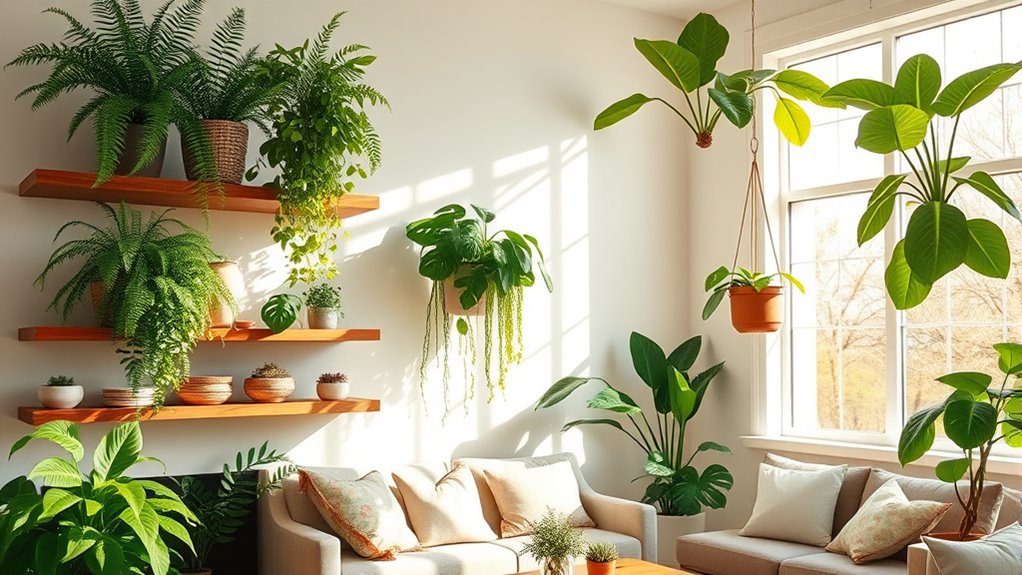
Indoor plants not only improve air quality but also considerably boost your overall well-being. They help reduce stress, enhance mood, and increase focus. Caring for plants provides a sense of accomplishment and connection to nature, which can alleviate anxiety and depression. The visual presence of greenery creates a calming environment, making your space more inviting. To highlight benefits, consider this table:
| Benefit | Effect |
|---|---|
| Stress Reduction | Lowers cortisol levels, calming your mind |
| Improved Mood | Increases serotonin, boosting happiness |
| Enhanced Focus | Promotes concentration and productivity |
| Better Sleep | Regulates air quality, aiding restful sleep |
Adding indoor plants isn’t just about aesthetics; it’s a simple way to nurture your mental health daily.
Frequently Asked Questions
How Many Plants Are Needed to Significantly Improve Indoor Air Quality?
You’re wondering how many plants you need to see real air quality improvements. Generally, having about 15-20 healthy houseplants spread throughout your space can considerably filter toxins and boost air purity. Focus on a variety of plants known for their air-purifying qualities, like pothos, snake plants, or peace lilies. Just make sure they get enough light and proper care, and you’ll notice fresher, cleaner indoor air.
Can Plants Remove All Types of Indoor Air Pollutants Effectively?
You might wonder if plants can remove all indoor air pollutants effectively. While they do help reduce many common toxins like formaldehyde and benzene, they can’t eliminate every pollutant, especially in heavily contaminated spaces. Plants work best as part of a broader air quality strategy, including proper ventilation and air purifiers. So, don’t rely solely on plants but see them as a helpful, natural addition to your air-cleaning efforts.
Do Indoor Plants Require Special Lighting to Purify Air?
You wonder if indoor plants need special lighting to clean the air. The answer might surprise you. While some plants thrive in bright light, many can purify air even in low-light conditions. You don’t have to set up fancy lamps; regular indirect sunlight often does the trick. So, don’t worry—your green friends can help improve your indoor air quality without complicated lighting setups.
Are There Any Safety Concerns With Toxic or Allergy-Inducing Plants Indoors?
You should consider safety when choosing indoor plants, especially if you or your family members have allergies or small children. Some plants are toxic or can trigger allergic reactions, so it’s essential to research each plant’s safety profile. Always keep toxic plants out of reach and opt for non-toxic varieties if you have pets or allergies. Proper placement and awareness help you enjoy the benefits without risking health issues.
How Quickly Can Indoor Plants Improve Air Quality After Placement?
You wonder how fast indoor plants can make the air better. Once you place them, you might notice improvements within a few days, especially if you choose plants known for air purification. Plants like pothos or snake plants start absorbing toxins and releasing oxygen pretty quickly. Keep in mind, the overall air quality will improve gradually over weeks with consistent care and proper placement, so patience is key.
Conclusion
Think of your indoor space as a gust of invigorating mountain air, with plants acting as your natural filters. By choosing the right plants and caring for them well, you turn your home into a lush oasis that clears away toxins and boosts oxygen. Just like a gentle breeze sweeps through, your indoor garden refreshes your environment and your well-being. Embrace these green allies, and let your home breathe easier every day.
